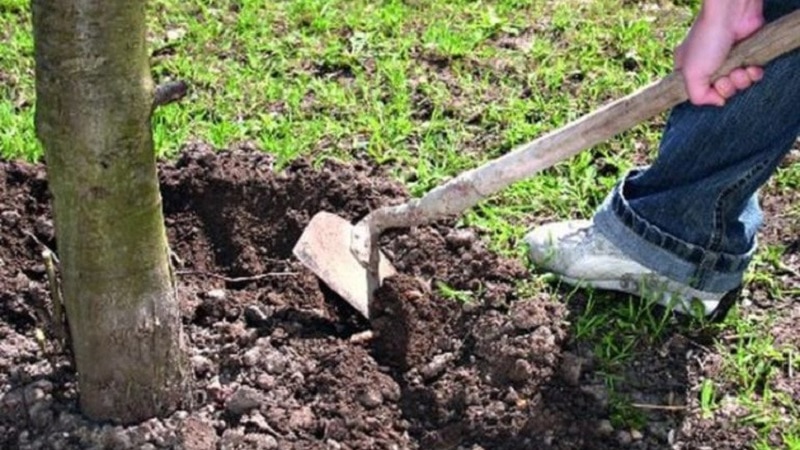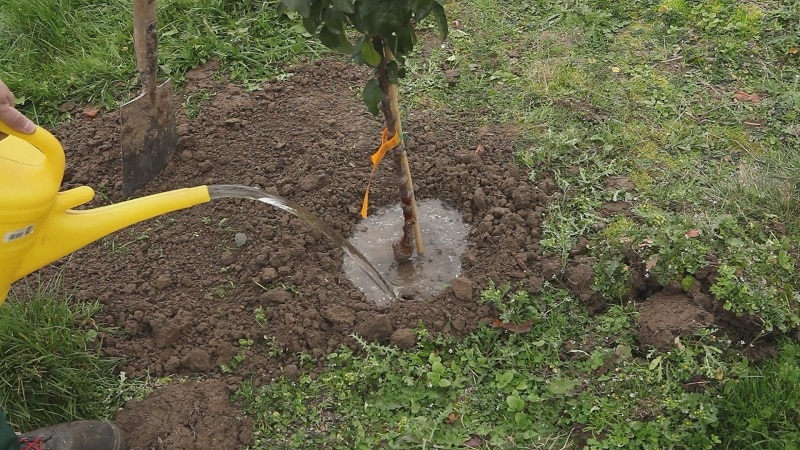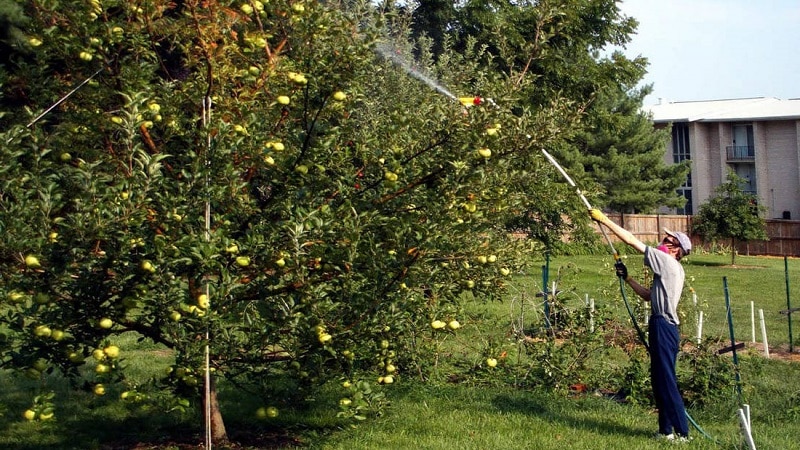Feeding apple trees correctly in the fall: all the ways
One of the mandatory stages of caring for apple trees is fertilizing in the fall. The plant is preparing for winter; next year it is important for it to accumulate nutrients, and depleted soil does not saturate it. In this case, you cannot do without fertilizers. We'll tell you how and what to feed the apple tree after harvesting.
Do apple trees need fertilizer in the fall?
In autumn, the apple tree needs feeding, as after a good harvest it becomes depleted. To her it is important to recover, strengthen your immune system in order to survive the winter without problems and be resistant to diseases and pests.
Important! Fertilizers are applied to moist soil so as not to burn the roots.
Feeding apple trees in the fall increases the formation of flower buds and the quality of ovaries for the next year. As a result, the plant will produce fruits with good shelf life.
Types of fertilizers used in autumn
Autumn feeding is not limited to one type of fertilizer. Wood requires organic matter and minerals equally. Many gardeners prefer folk remedies.

Mineral
Autumn minerals are phosphorus and potassium. Both adult fruit-bearing trees and young ones are fed with products based on them.
Popular mineral fertilizers:
- Superphosphate. The most effective phosphorus fertilizer, which is ideal for apple trees. Contains phosphoric acid, magnesium and sulfur. Simple superphosphate includes up to 20% phosphorus, double superphosphate - up to 50%.
- Ammophos (diammophos). Obtained by adding ammonia. Phosphorus content - 50%.
- Potassium metaphosphate. Consists of phosphorus oxide (60%) and potassium oxide (40%). The mixture is well absorbed by acidic soils.
- Potassium chloride. The most common potassium supplement containing up to 60% potassium.
- Potassium sulfate. Contains 50% potassium, as well as magnesium, sulfur and calcium.
- Wood ash. The natural mixture consists of potassium and various trace elements.
Phosphorus and potassium supplements are added simultaneously. Many gardeners use complex mixtures of various minerals. “Florovit”, “Ekolist”, “Active” are widely used.
Note! Nitrogen-containing fertilizers are not used in the fall, as they stimulate vegetative growth.
Organic
Mineral fertilizers for apple trees are sometimes not enough, so in the fall, organic matter is also added to the soil.
Effective organic fertilizers:
- Humus. Consists of rotted remains of plant and animal origin. It is diluted with water in a ratio of 1:10.
- Manure. Used in the fall to dig up the soil under a tree. Apply up to 10 kg per 1 m².
- Rotted horse manure. Since the composition contains ammonia, fertilizer is added carefully so as not to damage the roots of the plant. This is especially true for young (up to 3 years old) apple trees.
- Chicken droppings. Usually used dry. The composition contains nitrogen, so in the fall, when digging the soil, manure is added in small quantities: 100 g is diluted in 15 liters of water and infused for 6-8 days before use.
- Green manure — fodder and legumes, rapeseed, mustard. After gaining sufficient green mass, the plants are embedded in the soil. They contain many micro and macroelements.
- Vermicompost. Obtained as a result of the vital activity of worms. Contains beneficial bacteria and nutrients that strengthen the plant's immunity. Biohumus is concentrated black soil.It is diluted in water (0.5 kg per 10 liters) and used for irrigation.
- Wood sawdust. Improves soil composition. They are added to compost as mulch and mixed with manure.
Interesting things on the site:
Traditional methods
Experienced gardeners folk recipes are often used to feed apple trees:
- Potassium permanganate solution. The trees are watered in a circle around the trunk with a faint pink solution. The product disinfects the soil, improves the condition of plants, and promotes the development of the root system.
- Yeast. More often they are used to feed young trees. To prepare the solution, take 0.5 kg of yeast, 3 tbsp. sugar and 9 liters of water, leave the mixture for 7 days. For irrigation, dilute the solution with water in a ratio of 1:20. 1 apple tree requires up to 3 liters of fertilizer.
- Clay chatter. To prepare, clay and peat are diluted in equal proportions in 10 liters of water. Fertilizer enhances the effect of minerals and the plant’s absorption of nutrients from the soil.

Methods and timing of fertilization
Fertilizers cannot be applied randomly; there are established deadlines for this. Gardeners are guided by weather conditions or the lunar calendar.
Feeding time
Fertilizers can be applied to apple trees immediately after harvesting.. Autumn fertilizing begins in early September and ends 2-3 weeks before the first frost.
On a note! According to the lunar calendar, plants are recommended to be fed during the waning moon.
Favorable numbers in 2020:
- September: 4–8, 11–14, 19–25, 29–31;
- October: 9, 13, 18, 21, 27.
In 2021:
- September: 1–5, 11–18, 24–30;
- October: 8, 12, 16, 17, 21, 22.
Root method
Before applying fertilizers, the soil is dug up along the trunk circle of the apple tree at a distance of 50–70 cm from the trunk. This is done with caution so as not to damage the roots of the plant. The procedure is required for better penetration of substances into the ground.
Fertilizers are scattered over the dug up area. It is more convenient to apply dry fertilizers in rainy weather, liquid fertilizers in dry weather.
Foliar method
In this case, the plants are fed by spraying the foliage, branches and trunk. The procedure is carried out in early September, before rainy weather begins. During the rains, there is no point in spraying apple trees.
Reference. Foliar spraying in the fall is also used to control pests. For example, use a solution of copper sulfate.
In dry weather, leaves quickly absorb nutrients, which affects future bud formation.

Hole method
Similar to root, but it has a difference. Holes up to 25 cm deep are dug around the tree trunk. Fertilizers are poured into them. Dry fertilizers are watered. It is better to lay mulch on top.
The method is used for adult apple trees, whose roots are deep in the ground and allow them to dig such deep holes.
Read also:
Guide to planting an apple tree with a closed root system
How to feed an apple tree for a good harvest
Is there a relationship between fertilizing and the age of the apple tree?
An apple tree is considered young until 5–8 years old. A 10-year-old tree is already mature.
The concentration of fertilizers and the composition of substances depend on the age of the plant.. Dry mixtures are not suitable for young apple trees, as they can burn the roots. Solutions for them are prepared in half the ratio specified in the instructions. In autumn, organic matter has a greater effect. Plants tolerate winter better and develop more actively in spring.
Note! Mature and old apple trees require equally mineral and organic compounds with correctly calculated concentrations.
Conclusion
Autumn feeding is one of the most important stages of caring for apple trees. Fertilizers help them survive the winter and set buds for the future harvest. They use mineral and organic substances, adding them in different ways. In this case, the age of the plants, timing and weather conditions are taken into account.